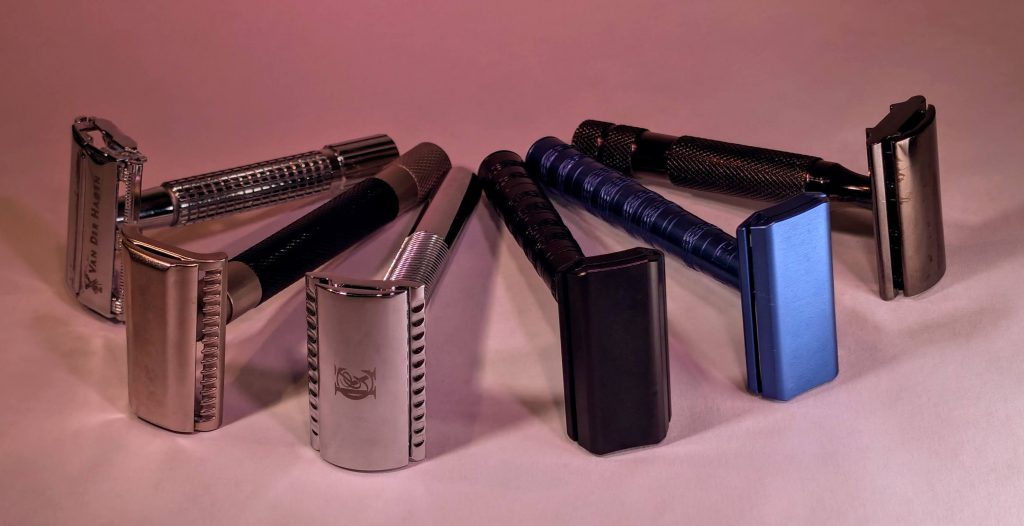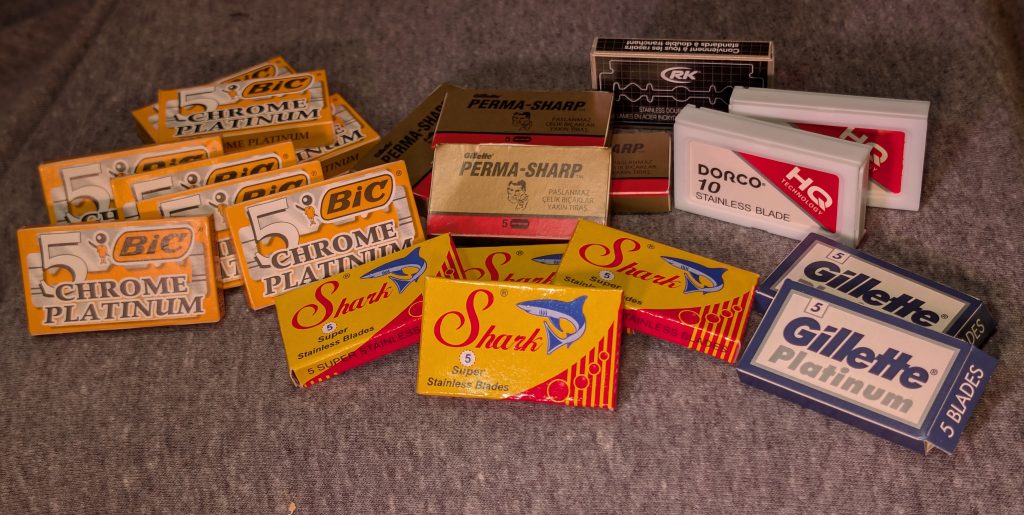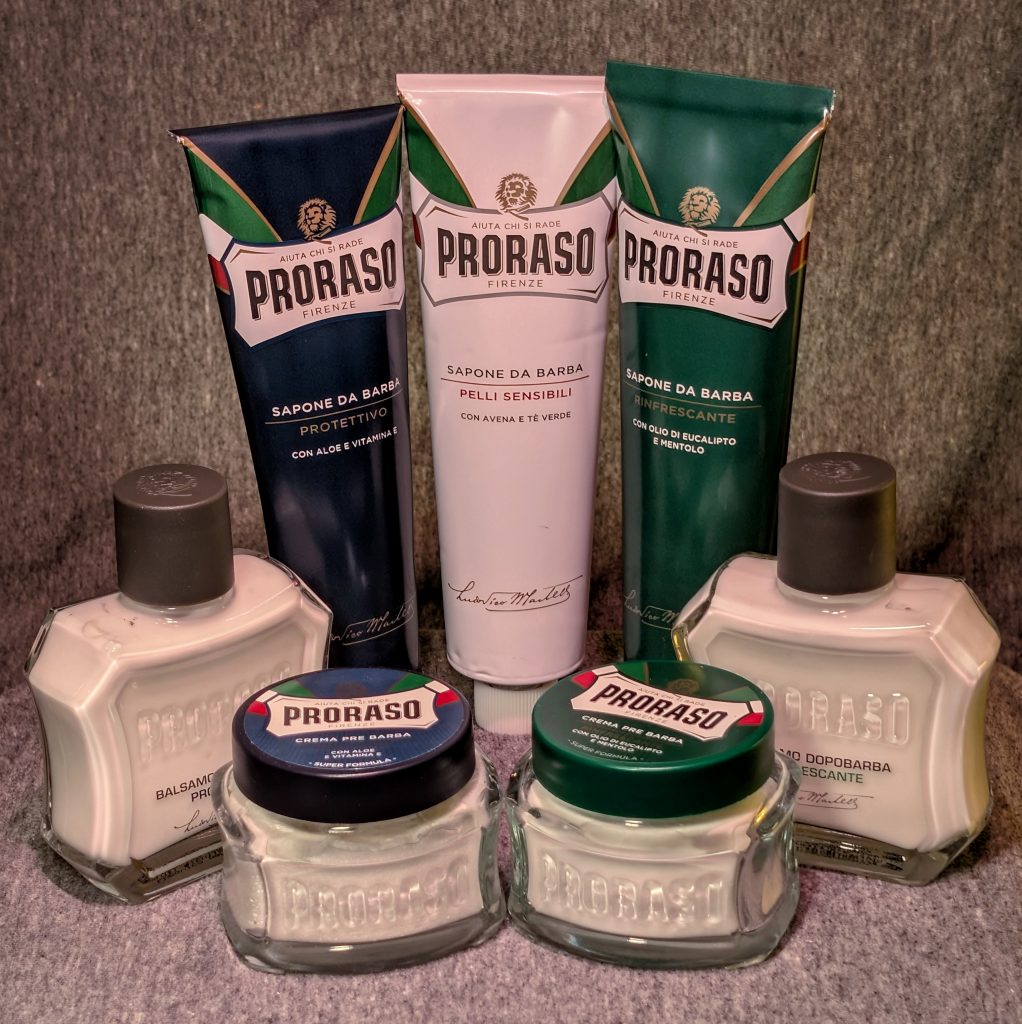There will be shaving reviews, notes, and other posts about shaving here, because that’s something I’ve gotten into of late (see the history here). But there are things that you, the reader, will need to know going in to help you understand these posts.
Some Terminology
Razors:

Obviously, you can’t shave without a razor of some kind. And the term razor refers to the thing that holds or contains the blade that does the actual cutting of the hairs. There are a few different types of razor: straight, shavette, single-edge safety, double-edge safety, and cartridge, just to name a few. Though a straight razor is actually designed and intended to be a permanent (with some periodic sharpening and honing) blade as well.
Razors are always considered “hardware” in the wetshaving world.
I’ve had an experience with a shavette, which has the same form factor as a straight razor, but instead of a permanent blade as on a straight razor, the shavette has replaceable blades that can be inserted. This experience was at a men’s barber that offered shaves, and while the whole experience was really enjoyable (hot towels, hot lather, and just the pampering are worth it alone), and the shave was very close, the amount of razor burn I experienced coupled with the sting of the after shave splash was not enjoyable for a few hours after the shave. Again, I liked the experience, but with some consultation with the Reddit group, I’ve found that I should be able to better tell them what I’d like from the shave in the future. But also thanks to the group, I’ve come to realize what kinds of pre and post shave prep my skin likes.
Beyond that, the whole of my shaving experience since quitting cartridges has been with double-edge (DE) safety razors. This is the most common and what you probably think of when you think of an old-style razor. These days, though, they’re anything but old-style.
Razors are engineered to provide a close shave with a minimum of irritation or razor burn. So there’s a lot of variety in things like the blade exposure, blade gap, angle, etc. The combination of these things contributes to an overall description (or rating–I’ll use that term too) of the razor as being mild, medium, or aggressive, with steps in between. These ratings are rarely in dispute in shaving circles, with exceptions to people who may be too sensitive to shaving, or not very sensitive.
A mild razor will basically limit the amount of blade exposure on the razor, ensuring that the blade won’t try to cut too closely to the skin. This is the key–either ride on the skin and don’t cut it, or ride slightly above and cut the beard hairs. Frequently, people will say that a mild razor is inefficient, i.e. it won’t cut as close and may require more than the sort of standard two or three passes–With the Grain (WTG), Across the Grain (XTG), and (not preferred) Against the Grain (ATG). More on those terms later.
A medium razor, then, works to get the blade closer to provide a closer shave, meaning the shave should be more efficient. And aggressive goes even further. Theoretically, with a proper setup for your face, anyone could use an aggressive razor with a good blade and achieve a flawless shave in a minimum of passes with little or no irritation. But skin, blades, razors, hands, soaps and creams, etc. aren’t perfect and all are different, so this is not likely to happen because, after all, you’re dragging a blade across your skin to cut hairs.
There are a few complications here in terms of design characteristics to DE safety razors, including a slant design, and open- and closed-comb designs. These are designed either, as with the slant, to angle the blade in such a way that it acts more like a guillotine, providing a slicing action versus a chop, or with the comb designs to help guide the hair into a positive position for the blade. I’ll talk to those some other time.
Blades:

Blades are the other absolute requirement to DE safety razor shaving.
Blades, too, have an aggressiveness. Or sharpness. Or edge profile. Or something. There’s a lot of debate about whether blades are physically capable of being aggressive or if it’s just a combination of sharpness, cut quality, and ability to hold its edge for multiple shaves. At any rate, however they’re made and sharpened can translate to an aggressiveness that can contribute to or detract from the comfort and closeness of a shave with a razor. Feather brand blades are widely considered to be the sharpest blades made, but they’re also known to not hold a clean edge for much more than 3-4 shaves in most cases. I’ve also tried a blade that is referred to by some as mild (a Gillette 7 O’clock yellow), and found that when used in a mild razor, it barely feels like the blade is in contact with your skin. Big points for comfort, but the shave, unsurprisingly, was not close. The bottom line here is that blades are difficult to quantify, but very easy to notice differences between brands. With that being said, though, I’ve appreciated an aggressiveness rating that Razor Emporium has put on the blades that they sell. This has been helpful to me to be able to better compare a blade before using it with one that I’ve already used.
Blades are typically sold in “tucks,” which are small boxes of 5 or 10 blades each. Most come in small cardboard boxes, but some, like the Dorcos shown above, come in a spring-loaded plastic package, where the used blades can slot in toward the bottom of the box and new blades slide out of the top.
Brushes:

Also considered hardware because they’re semi-permanent.
Brushes can come in a variety of types and designs. They’re usually measured by the size (at the base) of the knot, which is the bundle of bristles collected together to make the brush. But then there’s the loft of the knot, which refers to how far down into the handle they’re placed. A deeper loft means the brush won’t fan out as much at the tip.
Then there are the types of bristles used. My first brush was a goat bristle brush set in a bamboo handle. It sucked. It wasn’t dense, the bristles came out easily even when it was new, it did not retain its shape, and it never felt like it retained much water.
The two brushes on the right as shown above are boar bristles. They’re generally stiffer, less flexible bristles that some people (especially with sensitive skin) do not like because they feel prickly. I do not find this to be the case, even though I do have sensitive skin. They hold water and lather well, and because they’re a bit stiffer than other bristles, they work very efficiently at generating a lather.
Badger brushes (like the one on the left above) are softer, but usually denser brushes. They take up water very well, and feel very nice on the skin because they are more flexible and less stiff. But they require some more patience and slightly different lathering technique than the boar bristles.
Synthetic brushes are just that: brushes made out of synthetic bristles. I don’t have an example of this (yet), but I’ve found that they can range the gamut between being stiff and soft, though most tend to the softer side but some people prefer them due to the animal or gamey scent of the boar or badger bristles.
Software:

On the “software” side…oh wait. Blades are widely considered to be software as well because they’re a consumable. Oh well, moving on…
On the software side, you get the soaps, creams, gels, foams, and whatever other forms of lubrication and support there is out there to help make a shave more pleasant. Soaps and some creams get lathered with a brush, and there are several types, which I’ll talk about elsewhere. Some creams, gels, foams, butters, etc. usually just get applied by hand with no lathering in a cup, bowl or with a brush. In some circles of the shaving community, these are dismissed with an insistence that soap or a good cream lathered with a brush in a bowl, cup, or directly on the skin is the only way to go. I disagree, because I’ve had very good experiences with a couple of non-lathered products. But I’ve also had great experiences with lathered products as well.
There is much discussion about preparation for shaving: hot water or a steaming cloth applied to the face and held there for a few seconds to a minute, or cold water (kind of a new thing that some are trying), or just the steam and warmth of a shower combined with a good face wash or scrub, or even some who just use the water needed to make a lather as the only liquid in the process. Then there are pre-shaves (oils, creams, sticks, soaps, lotions, etc.). These are intended to add a layer of lubrication below the shave soap, cream, foam, gel, etc.
And the post-shave routine can be just as involved. There are septic sticks that can stop bleeding if you get a nick or cut. A wet alum block rubbed on the face helps to ease razor burn and prevent razor bumps. And then there are witch hazel toners, alcohol or non-alcohol splashes, balms, creams, lotions, butters, and the like can be applied. For me, using some of these products has also entirely changed my shaving experience. My skin loves a good after shave balm or cream.
Technique:
My routine, and I’m sure I’ll expand on it and talk about it more in the future, is kind of a happy medium: on shave days, I’ll shower, use a good face wash, then after the shower, go to the sink and use a warm to hot washcloth on my face, then apply a pre-shave, a shave soap/cream/gel, do the shave. Afterward, I’ll usually wipe a wet alum block on my face, let that sit for a minute or so while I apply beard oil to my beard, then wipe off the alum with the damp cloth, and then apply the post-shave balm or cream.
The general rule of thumb for shaving is to take a first pass with the grain (WTG), that is, in the direction the hair is growing. The soap/cream/gel can be reapplied if needed, and then the second pass is across the grain (XTG), that being perpendicular to the direction of hair growth in either or both directions. If needed, again, more soap/cream gel, and then against the grain (ATG), or in the opposite direction to the direction of hair growth.
Against the grain is…I don’t want to say controversial, but some argue strongly against it, and others say it’s necessary. The argument against it is that it contributes to or encourages ingrown hairs and razor bumps which leads to problems and a sub-par shaving experience. A key argument for it, which I tend to support, is that the other two directions don’t fully remove the hair, and this final pass gets the closeness we want. And there are ways to mitigate any razor bumps and ingrown hairs.
Razor angle is key. I’ve seen many posts that talk about a 30 degree angle of the blade to the skin. But some razors seem to promote a stronger angle. Some razors, such as the Henson Shaving razors, make finding that angle dead easy. Others, not as much. So there is some need to develop the muscle memory to find that proper angle where the blade can be most efficient and least painful.
There is also technique to lathering soap. I’ve only been doing this now for about 3 months, and one of those was spent trying to use a poorly lathering soap and a terrible goat-hair brush. I mean, it could also have been me trying to figure things out, but when paired with a very good soap and an excellent brush, I have yet to not make a good lather. It’s just finding the right amount of water so it isn’t too thick or thin.
The Individual:
Fortunately in this community, there is wide recognition that every face is different and responds to different products differently. And even within that, faces and necks (and even heads for those who shave there) can demand different treatment. I have yet to go this far, but there are some who use different setups for different parts of their face or neck.
So keep in mind that any review or commentary about a product here is subjective. In fact, any review or commentary about a shaving product anywhere is subjective. My face will not react exactly the same way as some one else’s. I can generalize and say that as someone with sensitive skin on my neck, and the tendency toward razor burn and razor bumps there, if a product helps prevent that, it would be worth it for someone with similar experience to try that product. But again, if I say it works, it works for me. Your mileage may vary.
For me, I have a partial beard, that I keep trimmed and shave my cheeks and neck so that I don’t develop the wolfman look. My cheeks don’t seem to care which way the shave goes: with, against or across the grain. Usually just two passes are needed, the first against, then the second with–no, I don’t understand it either, but it’s always comfortable, even with a 3 day growth to cut through.
My neck, though, would revolt if I started with against. Usually, I’ll do two passes across the grain–once from the bottom up, because my beard, except for a narrow strip down the center of my neck, grows out and eventually up toward my ears (that tracking of direction of hair growth is called beard mapping). After that, if it’s still needed, I’ll do a pass against the grain, and then stop. I’ve learned that more passes on my neck have a diminishing return–more irritation for less closeness. So I’ve determined that I just need to stop and cut my losses at that point.
My goal in every shave, outside of just experimenting to see how a particular combination works for me, is to achieve a close shave with minimal post-shave stubble feel, and little to no razor burn.
There we go. Some of the basics you need to know. Thanks for reading!